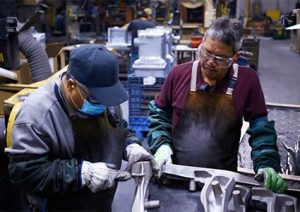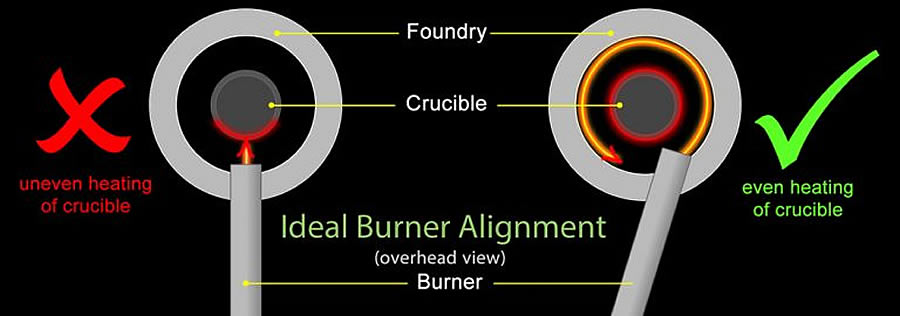Exactly How Aluminum Foundry Adds to Innovations in Aerospace Design
Aluminum foundries are integral to advancements in aerospace design. They create lightweight, high-strength parts that are vital for modern aircraft. Via innovative casting strategies, these foundries develop complicated geometries that boost structural honesty. Additionally, the advancement of premium Aluminum alloys supports the market's concentrate on fuel efficiency and sustainability. Nonetheless, challenges stay in the production process. Understanding these variables discloses the profound effect of Aluminum on air travel's future.
The Significance of Lightweight Materials in Aerospace Layout
As the aerospace industry remains to advance, the importance of lightweight materials comes to be increasingly noticeable. The demand for performance and sustainability drives engineers to prioritize using products that lower overall weight without jeopardizing architectural stability. Lightweight materials, especially Aluminum, play an important duty in boosting gas performance, improving payload capacity, and increasing the overall performance of aircraft.
The combination of these materials permits for ingenious layouts, making it possible for suppliers to produce more aerodynamic shapes that can withstand severe conditions. The reduction in weight not only lowers functional costs however also adds to a lowered environmental footprint, straightening with worldwide efforts toward sustainability in aviation.
Advanced Spreading Techniques in Aluminum Foundries
Advanced casting methods in Aluminum factories play a critical role in aerospace engineering by allowing the production of light-weight and exact components. Innovations in mold and mildew style and precision spreading processes are vital in attaining optimal performance and structural stability. Furthermore, the growth of lightweight alloys improves the total performance and effectiveness of aerospace applications.
Cutting-edge Mold And Mildew Style
Innovative mold and mildew layout plays a necessary function in the performance and efficiency of Aluminum factories, particularly within the aerospace field. By leveraging innovative products and strategies, contemporary mold and mildews can be crafted to stand up to high temperatures and pressures, making certain peak performance throughout the casting procedure. These styles often include complex geometries that permit the production of lightweight yet structurally audio elements, crucial for aerospace applications. Furthermore, using computer-aided layout (CAD) software assists in accurate modeling, enabling shops to imitate and fine-tune mold layouts before physical production begins. This not just boosts the quality of cast components yet also decreases waste and lead times, resulting in substantial price savings. On the whole, cutting-edge mold and mildew layout is a keystone of progression in Aluminum Foundry innovation for aerospace design.
Accuracy Casting Processes
The effectiveness of innovative mold layouts perfectly incorporates with precision spreading procedures, which are necessary for producing high-quality Aluminum elements in aerospace engineering. These processes, including sand spreading, pass away spreading, and investment spreading, ensure the development of intricate geometries with tight resistances. Advanced methods like vacuum spreading and stress pass away casting boost the honesty and surface finish of the last items. Accuracy casting reduces product waste while making the most of the mechanical properties of Aluminum, crucial for aerospace applications. Additionally, employing real-time surveillance and progressed simulation devices throughout the spreading process permits instant changes, leading to boosted high quality control. Jointly, these precision spreading procedures position Aluminum foundries at the forefront of aerospace innovation, sustaining the market's need for reliability and performance.
Light-weight Alloy Growth
As aerospace engineers seek to enhance gas efficiency and performance, light-weight alloy development comes to be an essential emphasis in Aluminum foundries. These factories employ innovative casting strategies to create alloys that give premium strength-to-weight proportions. Technologies in alloy composition, including the consolidation of elements like lithium and magnesium, allow the production of materials that stand up to severe problems while reducing total airplane weight. Strategies such as die spreading and investment casting help with the accuracy production of intricate shapes, which are important for aerospace applications. In addition, continuous research intends to maximize these alloys for enhanced mechanical residential properties and enhanced durability. By focusing on lightweight alloy advancement, Aluminum foundries greatly add to the evolution of aerospace engineering, leading the way for much more lasting and reliable aircraft designs.

Enhancing Structural Honesty Through Aluminum Components
Aluminum components provide significant benefits in boosting architectural integrity within aerospace design. Their lightweight nature adds to overall efficiency while maintaining strength, which is necessary for aircraft efficiency. In addition, the stress resistance buildings of Aluminum help assure the toughness and reliability of aerospace frameworks under different operational problems.
Light-weight Material Advantages
While standard products usually jeopardize weight for toughness, utilizing Aluminum parts in aerospace engineering offers significant benefits in architectural integrity. Aluminum's lightweight nature adds to overall style effectiveness, enabling for even more streamlined aircraft that take in less gas, consequently enhancing sustainability. The material's outstanding strength-to-weight proportion warranties that components preserve resilience without including unneeded mass. This top quality fosters boosted efficiency and dexterity in flight, in addition to maximized payload capabilities. In addition, Aluminum's resistance to deterioration lengthens the lifespan of aerospace frameworks, minimizing upkeep expenses and improving safety. As suppliers increasingly embrace Aluminum alloys, the aerospace sector experiences a transformative shift towards extra effective and effective engineering services that prioritize both efficiency and ecological obligation.
Stress Resistance Residences
Different products possess unique residential properties, Aluminum's phenomenal anxiety resistance stands out as an important variable in boosting the over here architectural stability of aerospace parts. This resistance plays a vital role in making certain that airplane can stand up to numerous operational stresses, including fatigue, influence, and environmental problems. Aluminum alloys, particularly crafted for aerospace applications, exhibit high tensile strength while maintaining light-weight characteristics, allowing designers to design extra effective frameworks - Aluminum Foundry. Furthermore, the ability of Aluminum to sustain cyclic loading without significant contortion contributes to the long life and dependability of aerospace parts. As improvements proceed in Aluminum Foundry strategies, the advancement of stress-resistant Aluminum elements promises more improvements in performance, security, and efficiency across the aerospace industry, solidifying Aluminum's function as a preferred product in modern-day design
Fuel Efficiency Improvements Driven by Aluminum Innovations
As the aerospace market seeks to boost fuel efficiency, innovative uses of Aluminum have arised as a crucial service. Aluminum's lightweight nature significantly reduces aircraft weight, enabling lower fuel intake throughout trip. This decrease in weight is essential, as even small decreases can bring about substantial renovations in overall fuel economic climate.
Advanced Aluminum alloys, developed for enhanced stamina and longevity, allow makers to develop parts that preserve structural stability while minimizing mass - Aluminum Foundry. Additionally, the integration of Aluminum in airframes and engine parts promotes boosted the rules of aerodynamics, contributing to lowered drag and boosted performance
The adoption of Aluminum in aerospace not just meets the demand for fuel-efficient style yet also lines up with regulative stress for lower emissions. As these technologies remain to progress, they play a substantial function in establishing brand-new standards for fuel effectiveness, making sure that the aerospace market can satisfy growing financial and ecological obstacles.

The Duty of Aluminum in Sustainable Air Travel Practices
The raising focus on sustainable aeronautics practices has actually placed Aluminum as a vital material in the quest for greener aircraft style. Recognized for its lightweight properties, Aluminum significantly minimizes airplane weight, resulting in reduced gas usage and emissions. Its recyclability even more boosts its sustainability account, as Aluminum can be recycled forever without loss of top quality. This particular sustains a round economic climate within the aviation field, minimizing waste and source exhaustion.
Advancements in Aluminum alloys have actually enhanced their strength and deterioration resistance, enabling for longer solution life and lowered upkeep demands. These developments help with the development of a lot more effective airplane structures, contributing to general sustainability efforts. In addition, Aluminum's thermal conductivity plays you can check here a critical role in energy-efficient designs, enhancing systems such as warm exchangers. Collectively, these attributes underscore Aluminum's crucial duty beforehand sustainable air travel, straightening with international initiatives targeted at reducing the ecological effect of air travel.
Difficulties Encountered by Aluminum Foundries in Aerospace Manufacturing
While Aluminum factories play a necessary duty in aerospace production, they deal with significant obstacles that can impact manufacturing performance and top quality. One major difficulty is the rigorous quality assurance requirements needed in the aerospace sector. Any kind of defect can endanger security and efficiency, requiring strenuous assessment procedures that extend manufacturing timelines. Additionally, shops commonly contend with changing basic material costs, which can impact pricing and profitability. The intricacy of Aluminum alloys made use of in aerospace applications further makes complex the manufacturing process, as precise formulations are crucial for attaining preferred mechanical properties. Moreover, knowledgeable labor shortages impede the capacity to keep high-quality manufacturing degrees. Finally, environmental policies impose constraints on exhausts and waste administration, calling for factories to spend in sustainable methods, which can be cost-prohibitive. These factors jointly develop a landscape where Aluminum factories need to continuously adapt to meet the developing demands of aerospace production while making certain security and conformity.
Future Fads in Aluminum Applications for Aerospace Design
With developments in technology and boosting demands for performance, the future of Aluminum applications in aerospace engineering is poised for considerable makeover. The combination of innovative Aluminum alloys and compounds is expected to boost strength-to-weight ratios, resulting in even more fuel-efficient aircraft layouts. Furthermore, developments in additive manufacturing techniques will certainly allow for the manufacturing of complex Aluminum structures that were formerly difficult, enhancing efficiency and reducing waste.

Sustainable methods will certainly play a vital duty, with More Help a growing focus on reusing Aluminum to lessen ecological impact. The aerospace market is likely to embrace smarter making procedures, such as automation and man-made intelligence, guaranteeing greater high quality and precision in Aluminum elements. Moreover, collaborations between Aluminum factories and aerospace business will promote r & d, leading the way for new applications that meet the rigid needs of contemporary aerospace engineering - Aluminum Foundry. On the whole, the future looks promising for Aluminum's role in shaping the skies
Frequently Asked Concerns
What Are the Environmental Influences of Aluminum Manufacturing in Aerospace?
The ecological impacts of Aluminum manufacturing in aerospace consist of substantial power usage, greenhouse gas exhausts, and environment disruption. Additionally, mining procedures can result in dirt deterioration and water contamination, elevating issues concerning sustainability and environmental equilibrium.
Just How Does Aluminum Contrast to Other Materials in Aerospace Applications?
Aluminum uses an one-of-a-kind combination of light-weight homes, rust resistance, and cost-effectiveness contrasted to various other materials. Its high strength-to-weight ratio makes it especially advantageous for aerospace applications, enhancing fuel performance and total performance in airplane layout.
What Certifications Do Aluminum Foundry Employees Requirement for Aerospace Projects?
Aluminum Foundry workers call for customized training in metallurgy and spreading techniques, in addition to expertise of aerospace sector standards. Accreditations in high quality control and safety and security protocols are also important to ensure conformity with rigorous aerospace job needs.
Exist Any Type Of Safety Interest In Using Aluminum in Aerospace Engineering?
Security concerns pertaining to Aluminum in aerospace design consist of susceptibility to anxiety, tiredness, and corrosion fractures. Proper therapy and alloy choice are important to alleviate these dangers, making sure architectural honesty and total safety and security in aerospace applications.
How Does Aluminum Recycling Advantage the Aerospace Industry?
Aluminum reusing significantly benefits the aerospace sector by minimizing material prices, lessening ecological effect, and conserving energy. This sustainable method boosts the market's performance while advertising making use of light-weight, high-performance parts in aircraft production.
Advanced casting methods in Aluminum foundries play an essential role in aerospace engineering by making it possible for the manufacturing of precise and light-weight elements. Innovative mold and mildew design plays an important duty in the effectiveness and performance of Aluminum shops, especially within the aerospace market. As aerospace designers seek to improve fuel performance and performance, lightweight alloy growth becomes a vital emphasis in Aluminum shops. Aluminum alloys, particularly crafted for aerospace applications, exhibit high tensile stamina while keeping lightweight features, making it possible for designers to design a lot more efficient structures. Partnerships between Aluminum factories and aerospace business will promote study and development, paving the method for brand-new applications that meet the rigid needs of modern aerospace engineering.